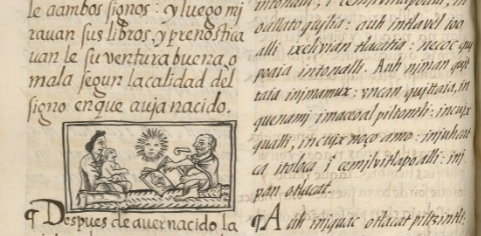amoxtli (FCbk6f168v)
This black-line drawing shows a man prognosticating for a woman and her baby son, consulting a divinatory book. The book, which is open, shows a human figure on one of the two visible pages. The man is older, bearded, and wears a cape (probably a tilmatli). A speech scroll comes from his mouth, indicating that he is telling the woman the fate of her child based upon what he is reading in the divinatory calendar. The man and the woman are seated on a woven mat (petlatl), and they are out of doors, given that the sun (with a face and numerous short rays) is in the air behind them.
Stephanie Wood
This is the first book in this collection (as of June 2025) to show a human figure on the page of a book. Interestingly, the page does not show the sign for speech (ilhuia) with opposing scrolls, which in other cases has taken to be a phonetic indicator for day (ilhuitl), suggesting almanac. See the drawings by John Montgomery published by FAMSI, Inc., which group tonalli, ilhuitl, and the two opposing speech scrolls as being semantically and phonetically connected as “ideograms for ‘day,’” which would point to the divinatory calendar, the tonalamatl. Perhaps the sun (tonatiuh, and an indicator for day, tonalli), provides the indicator in the iconography shared here about the divinatory calendar. In contrast with this example, most glyphs or iconography for books of the European type show little marks that suggest alphabetic writing or musical notation, not hieroglyphic writing or painted scenes. See some book examples, below.
Stephanie Wood
inimamux
in inamox
Stephanie Wood
1577
Jeff Haskett-Wood
libros, escrituras, pinturas, almanaque, almanaques, calendario, calendarios, divinatorio, divinatorios, adivinar, prognosticar
amox(tli), book or codex, https://nahuatl.wired-humanities.org/content/amoxtli
el libro
Stephanie Wood
Available at Digital Florentine Codex/Códice Florentino Digital, edited by Kim N. Richter and Alicia Maria Houtrouw, "Book 6: Rhetoric and Moral Philosophy", fol. 168v, Getty Research Institute, 2023. https://florentinecodex.getty.edu/en/book/6/folio/168v/images/0 Accessed 19 June 2025.
Images of the digitized Florentine Codex are made available under the following Creative Commons license: CC BY-NC-ND (Attribution-NonCommercial-NoDerivs 4.0 International). For print-publication quality photos, please contact the Biblioteca Medicea Laurenziana ([email protected]). The Library of Congress has also published this manuscript, using the images of the World Digital Library copy. “The Library of Congress is unaware of any copyright or other restrictions in the World Digital Library Collection. Absent any such restrictions, these materials are free to use and reuse.”






